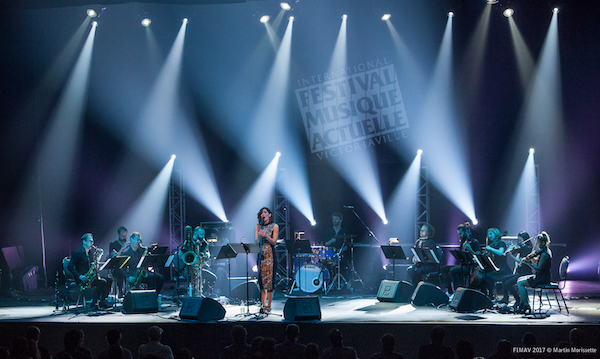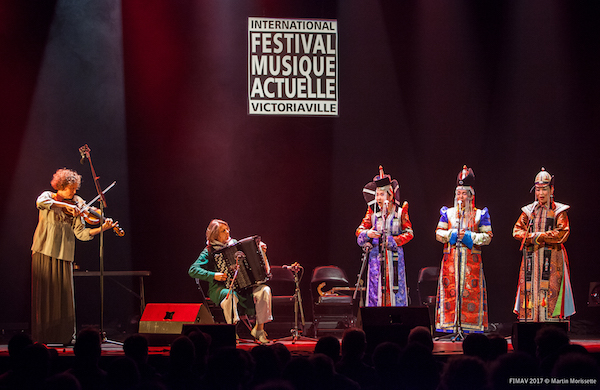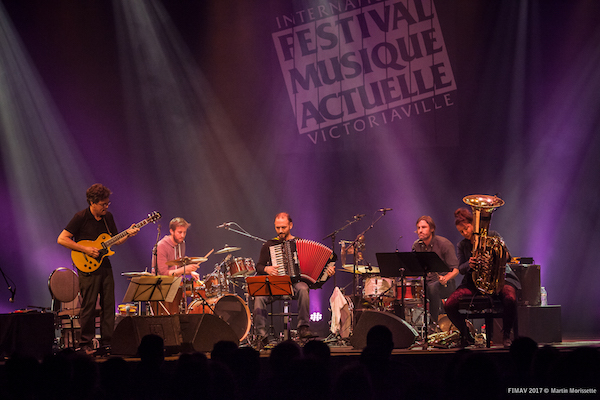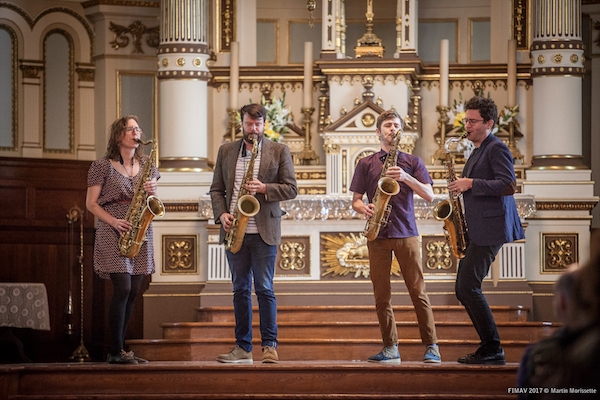Oct 28, 2025 10:47 AM
In Memoriam: Jack DeJohnette, 1942–2025
Jack DeJohnette, a bold and resourceful drummer and NEA Jazz Master who forged a unique vocabulary on the kit over his…

Tom Rainey (left), Scot Colley, Julian Lage and Nels Cline perform as the Nels Cline Four at the FIMAV Festival.
(Photo: Martin Morissette)Among other new developments at the unique cultural phenomenon that is FIMAV (Festival International Musique Actuelle de Victoriaville), 2017 was the year the beloved Quebecois festival went to church. Added to the long-standing centralized venue of a retooled hockey rink, the Colisée, and a shiny new downtown theater complex, the Carré 150, was the historic and almost extravagantly ornate 19th-century Église St-Christophe D’Arthabraska.
The sacred, reverberant space played host to a few early afternoon sets, including two of this year’s more innovative “discoveries” of the program—the tenor saxophone quartet Battle Trance and French organist Jean-Luc Guionnet, who worked some sonic magic on the church’s pipe organ, coaxing sounds and dissonant brushstrokes we never knew lurked within an organ’s innards.
Yes, there were the higher profile marquee dazzlers and old favorites in Victoriaville in May—a fabulous solo alto saxophone show by Anthony Braxton (who has played here many times, and recorded a handful of albums for the in-house Victo label); the fascinating and ruggedly individual Quebecois guitarist René Lussier; a few appearances by newly-anointed and palatable hero of the avant-garde scene, saxophonist Colin Stetson; and guitarist Nels Cline.
The latter two artists, apart from the engaging boldness of their musical visions, have a special audience drawing power partly due to their rock-world “day gigs”—Stetson with Arcade Fire and Bon Iver, Cline with Wilco. At FIMAV, they happily served as tent pole support acts, helping to balance out the chancier fare at a festival all about taking and embracing chances, experimentalism of all creeds and genres and free improvisation.

Megan Stetson (center) (Photo: Martin Morisette)
Conjuring up memories of when FIMAV regular John Zorn gave an improvised organ performance to cap off his 60th birthday marathon in 2014, Guinnet was perched at the organ console in the back of the Intrepid. Festival founder-director Michel Levasseur was the only figure sitting up front by the altar, suddenly looking like a rebel priest, sans vestments. He is, in a sense, the high priest of Victoriaville (the festival), although the soft-spoken but determined festival creator would no doubt cringe at the analogy.
From this home base in the smallish city of Victoriaville, two hours from Montreal, in the expansive dairy farming region of the Bois-Franc, Levasseur has seen his brainchild through for 33 years now, and kept the connected festival label Victo alive for 30 years. FIMAV is widely considered as one of the best, if not the best, avant-garde festival on this side of the Atlantic, and an admittedly strong influence on the much buzzed-about, young and daring Big Ears fest in Knoxville, Tennessee.
The latest edition only added to the legacy, with its judicious mix of jazz-related artists, left-of-center rock bands (such as the fresh-sounding neo-prog-rocky Bostonian unit, Bent Knee), enthralling music from unexpected global corners (the sizzling Indonesian duo Senyawa, and the German new-music partners Gunda Gottschalk and Ute Völker with iridescently-adorned and exotic singers, led by the famed Badamkhorol Samdandamba, fresh from Mongolia—a festival highlight).

Gunda Gottschalk and Ute Völker with the Badamkhorol Samdandamba singers. (Photo: Martin Morisette)
Classical resonances fed into the 2017 program as well, especially in Quebecois guitarist-composer Tim Brady’s narrative-lined tribute to Shostakovich’s Symphony No. 7 (with his admirably tight, minimalist-machined chamber ensemble Brady Works). On the festival’s opening night, Stetson unveiled his hour-long piece “Sorrow,” a meditative and moving “re-imagining” of Henryk Górecki’s ravishingly melancholic Third Symphony, for a chamber ensemble of Stetson’s special designing, including his sister, poetic and potent mezzo-soprano Megan Stetson.
Elsewhere on the classical/contemporary music radar, 82-year-old Terry Riley manned piano and other keyboards in fine form, dueting with his skilled guitarist son Gyan Riley (another FIMAV vet, who has previously put in memorable turns with Iva Bittová and Evan Zyporin in 2014 and, last year, with guitarist Julian Lage as part of Zorn’s “Bagatelles” extravaganza).
Other new developments in the 2017 festival were the use of a stylish new larger theater space in the Carré 150 to open the four-day, 21-show program with the absurdist theater-dance piece “Dollhouse” by rubbery (physically and conceptually) dancer Bill Coleman and found object sound manipulator Gordon Monahan. Dance later figured in, courtesy of the beguilingly slow-mo, yogic movements of French Myriam Gourfink, partly triggering the shuddering but textured wall of sound created by digital sound conjurer and “data_noise” artist Kaspar T. Toeplitz.
Film and video elements were also new avenues this year, fruitfully explored in sight-and-sound performances by Karl Lemieux (filmmaker and film program curator, actually hailing from Victoriaville) and B.J. Nilsen, and a world premiere from the Austrian Rdeča Raketa with video artist Micheala Grill, and rarefied experimental film screenings (including inspired vintage film/music pairings by Bruce Conner and Terry Riley) in the margins of an already dense weekend. Then again, packing worldly avant culture into a concentrated time frame in a lovely small town is what FIMAV is all about.

René Lussier Quintette (Photo: Martin Morisette)
Guitar culture from off to the side of normal is routine in Victoriaville, and the instrument was again well-represented. It was a pleasure to hear one of Canada’s most intriguing and stubbornly hard-to-categorize artists, Lussier, in action with his René Lussier Quintette—replete with accordionist Luzio Altobelli and tubist Julie Houle, and two drummers. Somehow, Lussier, on his Les Paul and on the bovine-esque serenading tool, the Daxophone, freely accessed a rangy musical menu variously suggesting Quebecois/Acadian folk, roadhouse rock grit, noise/free improv, raggedy cool Captain Beefheart-ishness (another bovine connection) and the nameless, half-crazed domain that is Lussier’s musical world.
Cline’s new double-threat guitar quartet is a dazzler, an outgrowth of the rapport and generous musical curiosity he shares with guitarist Lage, trading and dodging and weaving with each other in a mostly clean-toned palette, leaving the effects at home for this post-Jim Hall entity. The ace plectrists were artfully supported by the great drummer Tom Rainey (who easily slipped into the special elastic rhythmic dimension known Paul Motian time for a pair of Motian tunes) and unerringly right (and left, when suitable) bassist Scott Colley. This is a quartet to watch and listen for as it goes.
Unconventional saxophonic sonics and experimentation emerged as one of the festival’s themes, intentionally or not. Braxton was in high flying and widely referencing form during his 70-minute solo concert on closing night, and Stetson opened his Górecki-retooling concert with one of his gymnastic bass saxophones, steadily pumping air into the massive horn via circular breathing, and inventing a riveting 15-minute improvisation rich in overtone-tweaking, rhythmic thrumming and intuitive structure.
Meanwhile, back at church, the Battle Trance foursome neatly (and not-so-neatly, in a positive sense) embodied the promise of site, sound and concept, and, in some grander way, the festival’s aesthetic agenda. A new kind of tenor madness is afoot in this band led by Travis Laplante and here featuring Anna Webber, Patrick Breiner and Matthew Nelson, as they beautifully and raucously explored possibilities of timbre and notions of ensemble, singing through the horn, powering through fierce tuttis and broaching feathery, elegant lyricism, in a mixture rarely heard in a “sax quartet” setting. All the while, the music resonated and seemingly interacted with the sacred space, to memorable ends.

Anna Webber, Matthew Nelson, Patrick Breiner and Travis Laplante of Battle Trance (Photo: Martin Morisette)
FIMAV at 33, despite any weak links or moments of fuzzy focus, left a solid impression and offered comforting reassurance that the underground is still alive and well, and overground (at least for one long weekend a year), in Victoriaville. DB

Jack DeJohnette boasted a musical resume that was as long as it was fearsome.
Oct 28, 2025 10:47 AM
Jack DeJohnette, a bold and resourceful drummer and NEA Jazz Master who forged a unique vocabulary on the kit over his…

D’Angelo achieved commercial and critical success experimenting with a fusion of jazz, funk, soul, R&B and hip-hop.
Oct 14, 2025 1:47 PM
D’Angelo, a Grammy-winning R&B and neo-soul singer, guitarist and pianist who exerted a profound influence on 21st…

Kandace Springs channeled Shirley Horn’s deliberate phrasing and sublime self-accompaniment during her set at this year’s Pittsburgh International Jazz Festival.
Sep 30, 2025 12:28 PM
Janis Burley, the Pittsburgh International Jazz Festival’s founder and artistic director, did not, as might be…

Jim McNeely’s singular body of work had a profound and lasting influence on many of today’s top jazz composers in the U.S. and in Europe.
Oct 7, 2025 3:40 PM
Pianist Jim McNeely, one of the most distinguished large ensemble jazz composers of his generation, died Sept. 26 at…

Drummond was cherished by generations of mainstream jazz listeners and bandleaders for his authoritative tonal presence, a defining quality of his style most apparent when he played his instrument unamplified.
Nov 4, 2025 11:39 AM
Ray Drummond, a first-call bassist who appeared on hundreds of albums as a sideman for some of the top names in jazz…